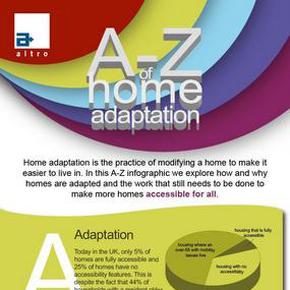
Smart Design: home adaptations helping us live longer at home
Home adaptation is the practice of modifying a home to make it easier to live in. Through this A-Z infographic by specialist flooring and wall cladding company Altro, we explore how and why homes are adapted, and the home adaptations that are still required to make them accessible for all.
 People today are living much longer than ever before, and as they get older they face the unenviable choice to either stay at home or move into care.
People today are living much longer than ever before, and as they get older they face the unenviable choice to either stay at home or move into care.
Still, before they reach this point they commonly take advantage of generous local government funding and have their home adapted so they can stay there longer – according to recent research by the National Body for Home Improvement Agencies, this funding can help delay a move to a care home by four years.
So what exactly are the adaptations they choose to help them live longer and happier lives at home?
Living Longer
According to recent government statistics, the number of over 65’s and older in the UK has passed 10 million. However, very few houses are ready for the challenges that old age brings.
Today in the UK only 5% of homes are fully accessible and a quarter have no accessibility features; this is despite the fact that 44% of households with a resident older than 55 include a person suffering from mobility issues or cognitive and mobility disorders, such as Alzheimer’s and Parkinson’s.
Funding life at home
Currently the Disabled Facilities Grant (DFG) provides up to £30,000 per application in England (£36,000 in Wales and £25,000 in Northern Ireland) for a range of home improvements including widening doors, installing ramps, improving access to rooms and facilities, and installing new heating systems.
What people receive is based on where they live and how much they earn or have saved, and the scheme is managed by local councils.
To help cope with the rising need the government is increasing investment in the DFG from £220m in 2015-16 to over £500m in 2019-20.
Clever home adaptations and improvements
As well as those already mentioned, there are some clever adaptations that this fund can be used for which really make a difference for older people.
The sad fact is that as people age they are more likely to experience trips and falls. One way around this is to lay specialist flooring. Interestingly, it’s not just grip that’s improved: For people with cognitive disorders and mobility disorders such as Alzheimer’s and Parkinson’s, specialist flooring can also help navigation between rooms.
Typically this flooring should be uniform throughout, with elements of contrast used to identify steps, doors and objects. Matt flooring is also preferred to complex patterns which can cause confusion.
Memory loss is an unfortunate reality of old age, but there are clever adaptations that can be made to increase familiarity within the home: As well as adding labels and textures, glass fronted cupboards can be installed so people can easily see what’s inside.
Specially adapted lighting is also a helpful modification; not only does it help people with reduced vision, it can also regulate sleep patterns for Alzheimer’s sufferers and improve general happiness.
There are also many small improvements that can help reduce potential judgement errors including fitting isolation valves on cookers, or adaptations such as easy-pull handles and adapted taps. And to help people cook for themselves, it’s common to adapt kitchen worktops so they adjust in height for wheelchair users.
Sources:
21st Century Challenges – Britain’s greying population
EFSD – Facts and statistics
Equality Human Rights
Alzheimers Online
Lumie – Tips for lighting and dementia care
Gov – Disabled facilites grant
Papworth Trust – Facts and figures
Gov – Disabled facilties grants (what you’ll get)
Dementia – virtual environments
Local Gov – Take a more balanced approach
Latest news

21st February 2025
ASSA ABLOY EMEIA: Save valuable time and money with a seamless switch to programmable digital keys
In 2025, access management can be a whole lot easier. By making access part of their digital processes, businesses can put time-consuming key management and the cost of changing the locks firmly behind them. Making this switch is a lot easier than many people think, as ASSA ABLOY explains here…
Posted in Access Control & Door Entry Systems, Architectural Ironmongery, Articles, Building Industry News, Building Products & Structures, Building Services, Doors, Facility Management & Building Services, Health & Safety, Information Technology, Innovations & New Products, Retrofit & Renovation, Security and Fire Protection
21st February 2025
Showersave supports industry leaders in addressing Part L and Part G regulations
Showersave has sponsored and participated in a recent Building Insights LIVE roundtable on ‘Water & Energy Saving Innovations in New Build Housing’.
Posted in Articles, Bathrooms & Toilets, Bathrooms, Bedrooms & Washrooms, Building Associations & Institutes, Building Industry Events, Building Industry News, Building Products & Structures, Building Regulations & Accreditations, Building Services, Exhibitions and Conferences, Interiors, Pipes & Fittings, Plumbing, Retrofit & Renovation, Sustainability & Energy Efficiency
21st February 2025
GEZE: The importance of Specifying High Quality Door Closers on Fire Doors
Andy Howland, Sales & Marketing Director at GEZE UK, discusses why specifying high quality door closers on fire doors is important…
Posted in Access Control & Door Entry Systems, Accessibility, Architectural Ironmongery, Articles, Building Industry News, Building Products & Structures, Building Regulations & Accreditations, Building Services, Doors, Facility Management & Building Services, Health & Safety, Posts, Restoration & Refurbishment, Retrofit & Renovation, Security and Fire Protection
21st February 2025
Insight Data achieves ISO9001 recertification with zero non-conformities
Leading industry data specialist, Insight Data, has successfully achieved the prestigious recertification for ISO9001 with zero non-conformities for the fourth consecutive year.
Posted in Articles, Building Industry News, Building Regulations & Accreditations, Building Services, Information Technology, Research & Materials Testing
 Sign up:
Sign up: